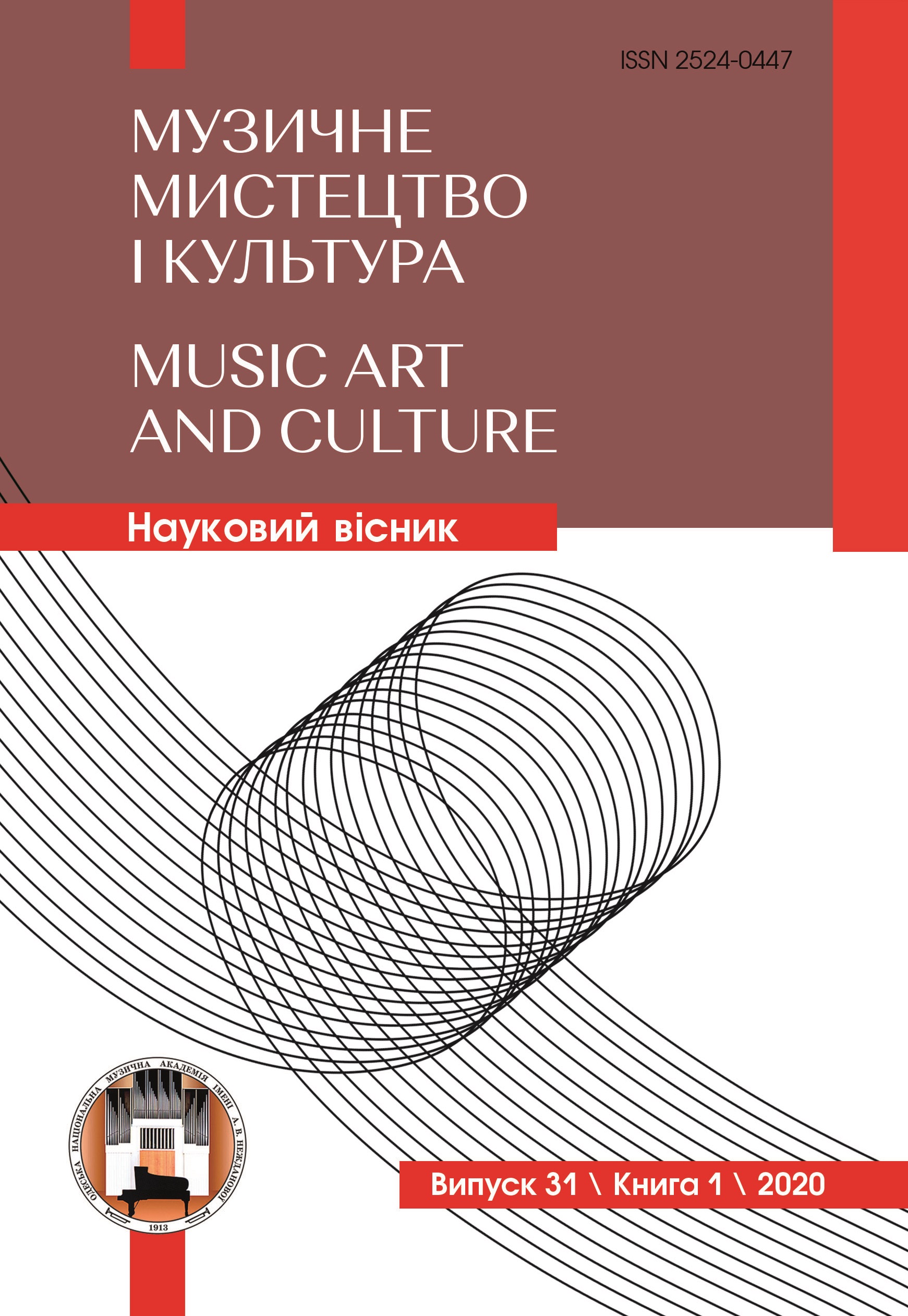ЕМОЦІЙНА ПАМ’ЯТЬ МУЗИКАНТА-ВИКОНАВЦЯ (ДО ПОСТАНОВКИ ПИТАННЯ)
Анотація
Мета статті – виявити структурну організацію емоційної пам’я- ті музиканта-виконавця. Розглянути алгоритм включення в роботу різних граней даного явища. Дати визначення поняття. Методологія дослідження полягає в постановці проблеми з точки зору історизму, системному відокремленні, а також виявленні взаємодії і взаємозалеж- ності різних пластів феномена емоційної пам’яті музиканта. Наукова новизна полягає в роз’ясненні та обгрунтуванні трьох граней емоцій- ної пам’яті музиканта-виконавця з подальшим виведенням визначення даного поняття. Висновки свідчать, що справжнє освоєння музичного тексту ставить завданням не тільки охопити твір напам’ять, але і просунутися далі – «дійти до самої суті», за Пастернаком [9], що для музиканта означає з ролі просто виконавця перейти в ранг виконав- ця-інтерпретатора. Якщо фізичний рівень сприйняття, відтворення, запам’ятовування музичного тексту має на увазі головування таких аспектів професійної пам’яті, як слуховий, зоровий і кінестетичний (з паралельним підключенням і конструктивно-логічного аспекту), то психологічний рівень має на увазі той формат зростання із твором, який відповідає суті вибудовування емоційної пам’яті виконавця. Ос- тання має на увазі: по-перше, максимально близьке знайомство з об- раним твором і композиторською мовою автора, проникнення в авто- ноетичну свідомість автора, стає об’єктивністю буття музики для самого «втілювача» ідеї і називається, по суті, семантичною пам’ят- тю виконавця. По-друге, напрацювання вже безпосередньо виконав- цем-інтерпретатором суб’єктивного багажу переживань художнього і особистого порядку – того резервуара або «архіву», який виступає основою репродуктивного та продуктивного виду діяльності артиста і буде називатися словом «інпут». І, нарешті, по-третє – відтворен- ня накопичень, утворених першими двома рівнями в уяві, для їх по- дальшого використання під час втілення вже піаністичних і художніх завдань. Емоційна пам’ять, таким чином, полягає в накопиченні, усвідомленні і збереженні досвіду об’єктивного композиторського, а також суб’єктивного чуттєвого сприйняття і переживання символів, що утворюють, у кінцевому рахунку, змістовну складову частину інтерпретації твору.
Посилання
2. Давидов В. Рассказ о прошлом. Ленинград – Москва : «Искусство», 1962.
3. Коган Г.М. У врат мастерства. Работа пианиста. Москва : Музыка, 1969. 341 с.
4. Меркулов А.М. Уроки Зака. Москва: Классика XXI, 2006. URL : https://ruslania.com/ru/noty/154479-uroki-zaka-sost-a-merkulovkniga-cd/ (дата обращения: 12. 11. 2019).
5. Нейгауз Г.Г. Об искусстве фортепианной игры. Записки педагога. Издание пятое. Москва : Музыка, 1987. 240 c.
6. Немов Р.C. Общая психология. В 3 т. Т. II. Познавательные процессы и психические состояния : учебник. 6-е изд., перераб. и доп. Москва : Юрайт, 2015. 1007 c. URL : https://books.google.com.ua/books?id (дата обращения: 10.11.2019).
7. Носина В.Б. Символика И.С. Баха. Тамбов : Междунар. курсы высш. худ. мастерства пианистов им. С.В. Рахманинова, 1993. 103 с.
8. Оганезова-Григоренко О.В. Автопоезіс артиста мюзиклу як творчий феномен та предмет музикознавчого дискурсу : дис. ... д-ра мистецтвозн.: 17.00.03 / ОНМА ім. Нежданової, НМАУ ім. П.І. Чайковського. Київ, 2018. 445 с.
9. Пастернак Б. URL : http://www.ruthenia.ru/60s/pasternak/kogda/vo_vsem.htm (дата обращения: 11.12.2019).
10. Савшинский С.И. Работа пианиста над музыкальным произведением. Москва – Ленинград, 1964. 185 с.
11. Станиславский К.С. Собрание сочинений. Т. 7. Письма. Проспект, 2015. 1295 с. URL : https://books.google.com.ua/books?id (дата обращения 12. 10. 2019).
12. Станиславский К.С. Работа актера над собой. Москва : ГИХЛ, 1938.
13. Теплов Б.М. Психология. Москва : Учпедгиз, 1948. 427 с.
14. Федорович Е.Н. История музыкального образования : учеб. пособие / Урал. гос. пед. ун-т. Екатеринбург, 2003. 110 с.
15. Швейцер А. Иоганн Себастьян Бах / А. Швейцер. Пер. с нем. М. Друскина. Москва : Музыка, 1964. 725 с.




 Музичне мистецтво і культура
Музичне мистецтво і культура